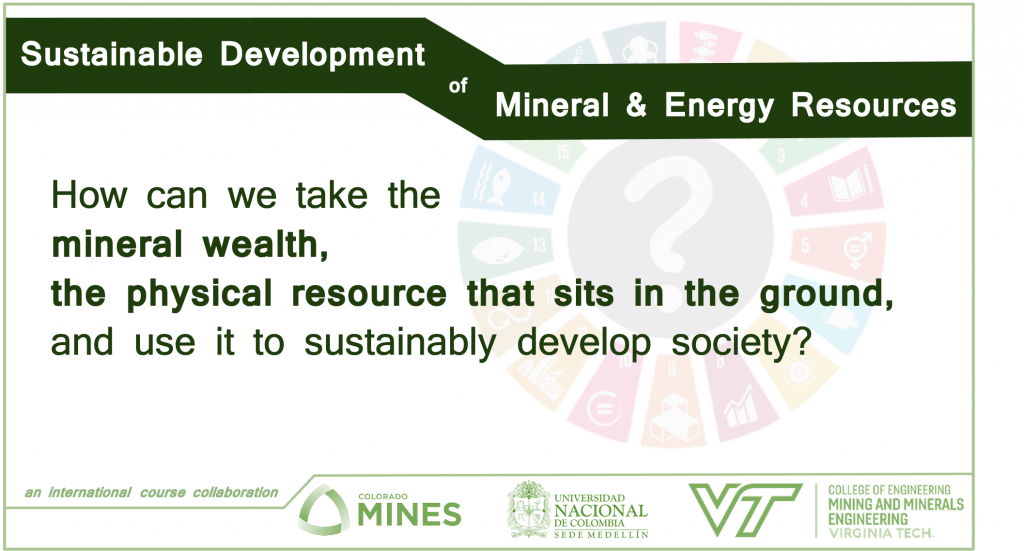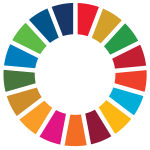Esta web utiliza cookies para que podamos ofrecerte la mejor experiencia de usuario posible. La información de las cookies se almacena en tu navegador y realiza funciones tales como reconocerte cuando vuelves a nuestra web o ayudar a nuestro equipo a comprender qué secciones de la web encuentras más interesantes y útiles.
Integrating the UN SDGs into Resource Engineering Using an International, Collaborative Course Model
Description
Institution
Virginia Tech, Colorado School of Mines and National University of Colombia-Medellin

Organizations/areas of the university involved
Virginia Tech (VT), Department of Mining and Minerals Engineering; Colorado School of Mines, Department of Mining Engineering (CSM); Universidad Nacional de Colombia in Medellín, Department of Materials and Minerals (UNAL)
Country
United States and Colombia
Exploring the opportunities and challenges for sustainable development in the context of mineral and energy resources: a case study of a collaborative engineering course between three universities.
Our collaborative engineering course explores the unique role of raw mineral and energy resources in the pursuit of sustainable development. Our target group includes graduate and undergraduate students in resource-related disciplines at three universities.
The course digs deep into the global demands for natural resources that underpin most all human endeavors, and the demands for more benign production. We challenge students to contend with the real conflicts posed by these competing demands. We inspire them to imagine and propose new solutions, whereby responsible resource development practices can contribute in net positive ways toward the economic, environmental and societal domains inherent to the UN’s SDGs.
Our collaborative course model was born out of early efforts, led by Dr. Dirk van Zyl (University of British Columbia), which sought to introduce mining engineering students to the rapidly evolving concept of sustainable development within the global metals industry. Our current model–and partnership–was conceived in 2017, and the course has been offered three times since. It consists of weekly meetings (via teleconference), where students participate in guided discussions and activities based on independent reading and research assignments. There is significant focus on the SDGs as a framework for evaluating resource development projects. Moreover, the SDGs serve as a theme for the course’s term project, which students conduct in cross-university groups.
In its current conception, we hoped this course would afford students an opportunity to view their engineering work through the lens of sustainable development, and pivot their design and management thinking accordingly. We made conscious efforts at an interdisciplinary approach, beginning with the instructional team. Our expertise blends traditional mining and environmental engineering (VT) with social science (CSM) and specific practical experiences working with artisanal and small scale mining communities (UNAL). We also set out to ensure that student engagement and interactions were maximized, even despite the remote format. This involved careful planning of our shared meeting times and term project.
We plan to continue offering the course using our current collaborative model (once a year), with regular content updates to track with SDG progress/needs in the context of mineral and energy resources.
Results and impact measured or expected
This collaboration is entering its fourth year and has reached nearly 150 students of at least 10 nationalities. Student feedback consistently indicates the course is successful in affecting learning and professional growth, with comments such as: “My perspective in terms of sustainable development has changed a lot. I understand its importance, which was ignored before this course. This course helped me reshape the concept of sustainable development.”
Aside from the “good chemistry” of the instructional team and the collaborative nature of the course, a critical success factor has been the institutionalization of the course at the partnering universities. At VT the course can be counted toward a Green Engineering minor. At CSM, the course has become a requirement for the graduate program in Earth Resources Development Engineering. At UNAL, the course is promoted as a valuable technical elective and as a key opportunity for students to practice English language skills.
Connection with the SDG framework
This course represents one avenue for integrating education for SDGs into resource engineering curricula. Our educational approach is to first equip students with a sustainable development knowledge base, including key principles, history and the evolution of the SDGs themselves. We then ask students to use that knowledge base, and their other curricular and practical knowledge, to engage in higher-order learning including critical analysis of case studies, problem definition and solving.
While the course is situated in resource engineering, our teaching approach is interdisciplinary. Specifically, traditional engineering problems (e.g., mine development) are met with social science and systems thinking to expand the scope and scale of proposed solutions. The course also constitutes a unique sort of multi-actor education. Beyond three primary instructors, we involve a variety of guests that bring real-world lessons. Moreover, our class community itself includes students from a diverse range of cultures, academic backgrounds and practical experiences.
Barriers and follow up
While teleconferencing infrastructure was a superficial barrier early on, our ongoing barriers are mostly associated with strongly-held conceptions of engineering work and identity, which do not always include an emphasis on social or environmental issues. For example, how can we convince students that SDGs should be a key part of the project design and management process? How do we inspire them to work toward goals that are not easily quantified, and where the payoff may not be immediate? To address these barriers, we take a scaffolded approach: first examining the fundamentals of sustainable development and its importance and relevance to the resources sector; then, through case studies, we examine how companies are attempting to engage in sustainable development, and apply an analytical lens to understand the opportunities and challenges that the cases present. A term project requires students to evaluate contributions to the SDGs based on a company’s sustainability reporting.
Transferability of the initiative
Our course model can easily be transferred across disciplines, and also geography and cultures. The essential resources are: an instructional team with shared interests and complementary areas of expertise, engaged students, and institutional support insofar as course administration. In addition to the transformative education related directly to sustainable development, we hold that the collaborative nature of the course has a multiplier effect for all involved. Further, it models the collaboration that is indeed required for progress toward the SDGs.
Although remote courses have often been viewed unfavorably, the COVID-19 pandemic has accelerated adoption–and our most recent course offering included students from four continents participating synchronously. We also find that language barriers can be overcome with committed students and an intentional focus on inclusivity. For example, while many students are non-native English speakers, they have been valuable contributors and routinely credit the course with helping improve their English skills and confidence.
Education 4 SDG funciona gracias a WordPress

